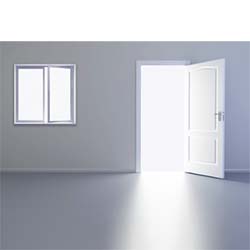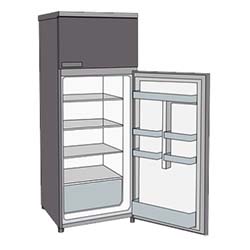Infrared Thermometer Temperature Checks
Monitored area considerations
Portable infrared thermometers are highly versatile tools that can quickly show temperature differences, cold or hot spots. These areas should be known and mitigated as much as possible, to reduce the influence of unwanted cold or hot air that may flow from there.
Areas that are both indoor and outdoor can have an influence. Intense summer sun can disturb just as well as cold drafts, and both of these influences can be determined using an infrared thermometer. Keep in mind that not the actual temperature is important as the difference between the average temperature and this intensely cold or hot spots.
Measurement height
It is good to know that both lower and higher areas in a building current plane can have an influence. Hot air at over 1 meter creates discomfort for breathing while colder one is comfortable, and the situation is reversed at lower heights. It is obvious that due to air stratification the tendency is precisely the opposite of the comfortable one, as cold air lingers near the floor and hotter air raises towards the ceiling.
The goal of height temperature measurements is, as always, to identify the largest temperature differences.
Recommended testing areas
Windows and doors, including the frame around them promote drafts and energy losses. While no window or door has an insulation as good as a wall, there are many situations where simply ensuring airtightness through good gaskets will help significantly. Keep in mind that large temperature differences may be unavoidable but air circulation may be easy to mitigate.
Few doors have proper airtightness and this means that sun, cold or hot air on one side of the door, may migrate not only through the gap between the door and the frame but also through the door or frame itself. This is particularly the case when the gasket is relatively good but the door is not. Large temperature differences near mechanical parts larger than 1 or two degrees from the center of the door, and particularly sudden changes near edges, indicate air flow that may affect comfort.
Windows are particularly affected by sunlight as well as drafts. The window frame is never airtight and all crevice, including water ingress ones, let some small amount of air to flow unrestricted. Intense sunlight is particularly troubling as it can severely increase the temperature inside the building, through an open or closed window. Measuring temperature of the internal windowsill around an area with intense sunlight and one where it is not shows immediately the impact of unwanted heat in summer.
Walls can have different temperature at the same height level due to losses near window or door frames, protrusions of various pipes and cable conduits as well as different building materials. While most interventions are difficult, the area around any object that enter or leaves a wall is of particular interest, as airflow and temperature differences are amplified there. External ventilation conduits areas are particularly prone to have airtightness issues.
Appliance testing
Large appliances that are operated for extended periods of time have an important impact on air temperature and the airflow around them is critical.
Refrigerators and freezers heat the air and walls around their back, increasing the temperature of ambient air. A good place for a refrigerator should be the coolest one in a building. Common locations such as kitchens are wasteful on electrical energy as the intense heat typical in these rooms makes the refrigerator work hard for to reach the desired internal temperature. Measuring temperature in different areas, both inside and outside is very helpful.
The backside of the refrigerator should also not be overly hot in operation, as temperatures of over 50 degrees in certain areas of the black condenser pipe grid on the back indicate poor airflow. This means that a refrigerator should be placed at a certain distance from the immediate wall behind its back, to ensure good airflow. Dust accumulation also reduces airflow and increases exterior temperature, reducing the refrigerator's efficiency.
Cooking appliances, whether they are cooking ranges, ovens, grills or other large units that heat food products, have an extremely large influence on nearby air temperature. While some heat is inevitably released, hot spots that are created near the back of appliances or sides can negatively affect comfort in invisible ways. Ideal placement and operation can be determined measuring the temperature in various places and at various times.
While heat is inevitably released, more energy efficient appliances or certain mitigations like aluminum foil reflectors or shields can reduce and direct heat from where it is undesired. Just as well, airtightness and insulation around ventilation conduits can improve airflow and reduce unwanted influence.
Heating/cooling installations
In summer it is highly important to have unhindered airflow from air conditioning units and their vents, this means that the temperature profile should variate as smoothly as possible from the area near the unit to one that is at the limit of it, typically on the floor. If comfort requirements are different, such as no cold air closer to working areas or near the floor, then the temperature difference measured should reflect this.
For exterior units, it is important to have no hot spots and proper unhindered airflow, so that the installation works efficiently. Dust or unwanted obstructions reduce the airflow and increase temperature more than acceptable in certain spots. Hot spots may be impossible to avoid but the is to have as smooth as possible the temperature transition between one side to the other. Of course, every part of the unit should be at specific temperatures, depending on operation requirements so readings should be considered accordingly.
Central heating units, water heaters and pipes including auxiliary units such as solar panel outlets should be well insulated. While heating any room through waste heat radiating from the installation may be acceptable this increases operational costs and make the unit perform poorly in very cold days. Checking good insulation, meaning low surface temperature on insulated parts, indicates good performance. Poorly insulated pipes increase thermal losses and make areas further from the heating unit perform particularly bad.
Note that airflow issues and the performance of the space heaters themselves can be assessed by monitoring temperature. Any sudden temperature difference on the surface shows poor water or air flow, reducing maximum efficiency. Partially clogged installations are suggested if the temperature drops as soon as branch occurs on the main pipe. Good performance is indicated if the difference between the main and return pipes is the highest.
Pipes
Any pipe that must carry a fluid at a certain temperature, whether used for cooling, heating or as part of a workflow requirement, can be checked if it reaches desired temperature values. Even if checks may be somewhat inaccurate, if they are done close enough and for installations that carry fluids at large temperature differentials, they can show valuable information. Just as well, issues with insulations can be easily spotted in a non-invasive way, as the insulation temperature is closer to a non-insulated pipe.
Room particularities
Every room has its own requirements that are determined or assumed to be within a range, as designed, and in the absence of current measurements. It is highly recommended that important areas are monitored first. While the below list offers only a guideline, the presented order reflects the impact of such environments on the whole building and its inhabitants' comfort.
Storage rooms, pantries, small warehouses
The most important requirement for warehouses is having a relatively uniform temperature profile or, if not, one that is predictable and adequate to a certain class of products.
Ideal positions are near exposed facade walls, doors, windows or other ventilation areas. Center floorplan positioning should be avoided as it offers no relevant information about humidity and temperature impact.




